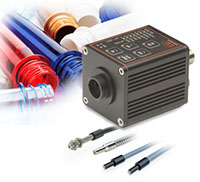| Items |
 OT colorSENSOR OT Color Sensor |
 ACS2-R45/0-28-1200 Circular Sensor |
 ACS3-TR5-200-1200 Fibre-Optic Color Sensor |
 ACS3-TR9-200-1200 Fibre-Optic Color Sensor |
 ACS3-TT15-200-1200 Fibre-Optic Color Sensor |
|||||
| Description | Color recognition using fixed optics at a distance from 10 to 800 mm |
The circular sensor ACS2 is used for color measurement of structured and highly reflective surfaces as well as lustrous metals. In the sensor, 24 lighting optics are circularly arranged around the receiving optics and provide a constant homogeneous lighting permitting that the measurement can be executed independently from the angular position of the measurement object. |
The transmission sensor ACS3 is used to measure self-luminous and transparent objects like foil, glass and Plexiglas. For the color measurement of self-luminous objects, only a receiver unit is required. Measuring transparent objects requires transmitter (TT) and receiver unit (TR) which can be installed with a mounting set. | The transmission sensor ACS3 is used to measure self-luminous and transparent objects like foil, glass and Plexiglas. For the color measurement of self-luminous objects, only a receiver unit is required. Measuring transparent objects requires transmitter (TT) and receiver unit (TR) which can be installed with a mounting set. | The transmission sensor ACS3 is used to measure self-luminous and transparent objects like foil, glass and Plexiglas. For the color measurement of self-luminous objects, only a receiver unit is required. Measuring transparent objects requires transmitter (TT) and receiver unit (TR) which can be installed with a mounting set. | |||||
| Color Difference | ≥ ΔE 0.5 | |||||||||
| Model | colorCONTROL ACS2 | colorCONTROL ACS3 | colorCONTROL ACS3 | colorCONTROL ACS3 | ||||||
| Article Number | 10824370 | 10824411 | 10824412 | 10824413 | ||||||
| Measurement Geometry (Illumination/Receiver) | 45º Circular/0º | Receiver | Receiver | Transmitter | ||||||
| Measurement Spot Diameter | 5 mm | 5 mm for < 100 mm | 9 mm for < 200 mm | 15 mm for 200 mm | ||||||
| Optional Measurement Spot Diameter | 9 mm | |||||||||
| Optimal Measurement Distance | 28 mm | 10 to 100 mm | 10 to 200 mm | 10 to 200 mm | ||||||
| Permissible Measurement Distance | ±1 mm of optimal measurement distance (ΔE<1) | 10 to 200 mm | 10 to 300 mm | 10 to 300 mm | ||||||
| Distance Tolerance | 1 ΔE/mm | <0.005 ΔE/mm <0.01 ΔE/mm | <0.005 ΔE/mm <0.01 ΔE/mm | |||||||
| Tilt Angular Tolerance | <0.3 ΔE/º | <0.05 ΔE/º | <0.05 ΔE/º | |||||||
| Ambient Light Tolerance at Maximum LED-Performance | <0.3 ΔE/1000 lux | <0.05 ΔE/1000 lux | <0.05 ΔE/1000 lux | |||||||
| Lens Diameter | 115 x 65 mm | 22 x 40 mm | 22 x 40 mm | 30 x 96 mm | ||||||
| Weight (Sensor Including Optical Fiber) | 822 g | 70 g | 70 g | 220 g | ||||||
| Length of Optical Fiber/Sensor Cable | 1.2 m | 1.2 m | 1.2 m | 1.2 m | ||||||
| Maximum Length of Optical Fiber/Sensor Cable | 1.8 m | 30 m | 30 m | 1.8 m | ||||||
| Bending Radius Sensor Cable | 70 mm | 70 mm | 70 mm | 70 mm | ||||||
| Protection Class | Ingress Protection (IP64) | Ingress Protection (IP64) | Ingress Protection (IP64) | Ingress Protection (IP64) | ||||||
| Operating Temperature | -20 to +70 ºC | -20 to +70 ºC | -20 to +70 ºC | -20 to +70 ºC | ||||||
| Storage Temperature | -20 to 70 ºC | -20 to 70 ºC | -20 to 70 ºC | -20 to 70 ºC | ||||||
| Shock Amplitude | 15 g. | 15 g. | 15 g. | 15 g. | ||||||
| Shock Duration | 6 ms | 6 ms | 6 ms | 6 ms | ||||||
| Note for Shock | According to DIN EN 60068-2-29 | According to DIN EN 60068-2-29 | According to DIN EN 60068-2-29 | According to DIN EN 60068-2-29 | ||||||
| Vibration Amplitude | 2 g. | 2 g. | 2 g. | 2 g. | ||||||
| Vibration Frequency Range | 10 to 500 Hz | 10 to 500 Hz | 10 to 500 Hz | 10 to 500 Hz | ||||||
| Note for Vibration | According to DIN EN 60068-2-6 | According to DIN EN 60068-2-6 | According to DIN EN 60068-2-6 | According to DIN EN 60068-2-6 | ||||||
| Features |
|
|
|
|
||||||
| Application |
|
|||||||||
| Additional Information |
Automatic detection of cable strands in the production process. Position, amount and strands differ depending on the cable. Due to a high rotational speed the wood turns dark. Due to color recognition early in the process, this effect can be compensated for. Monitoring of product packaging during the production process. In the food processing industry, the degree of burning or browning of e.g. coffee or cookies, can be detected. Detection of the color identity of painted attachments or body parts in automotive manufacturing e.g. to verify whether the color of the ultrasonic sensor is identical to the color of the bumper. |
|||||||||
| Advantages |
|
|||||||||
| Note |
For Measurement Spot Diameter:
|
For Measurement Spot Diameter:
|
For Measurement Spot Diameter:
|
|||||||
|
|
||||||||||
